-
Key Takeaways
- Enterprise AI chatbot development cost ranges from $5000 for basic solutions till $500,000 for complex systems in 2025
- Industry specific requirements such as healthcare HIPAA compliance or financial regulations may increase development costs by 25-50%
- Ongoing operational costs include hosting, maintenance, and updates range from $500 to $5,000 monthly.
- Core AI and backend development may show the largest cost component that accounts for 40-50% of the total project budget.
How Much Does Enterprise AI Chatbot Development Cost in 2025?
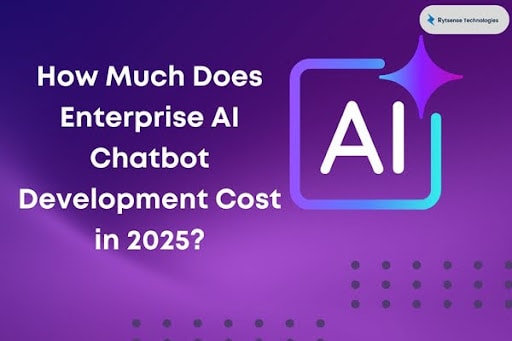
Knowing Enterprise AI Chatbot Development Cost in 2025 is paramount for companies navigating their digital transformation. Companies are spending more money on AI powered chat solutions to improve customer service, save on operating expenses and stay competitive in their respective markets.
Enterprise AI Chatbot Development Cost is highly variable in nature and can range from 5,000 to over 500,000 for highly sophisticated AI chatbot solutions. This variability in cost means that company leaders who are tasked with budgeting for an enterprise chatbot will need to understand what causes the variability in cost and how best to plan their budgets when investing in an enterprise chatbot project.
Understanding the exact Enterprise AI Chatbot Development Costs helps companies make sound technology investment decisions. It helps with proper budget planning, informed decisions about the right way to execute development options, and thoughtful expectation management for their AI chatbot development projects. Without this knowledge, companies might spend more money than necessary on features they do not need or, spend budget on a diminished capability that misses the potential of features that could generate worthwhile returns for the business.
AI Development Services have matured as of 2025, providing businesses with more features for the money. Companies who understand these costs can select an AI Development Services company - like the Best AI Development Company in USA - who provides true business value through a well built chatbot, within their budget.
Understanding Enterprise AI Chatbots and Their Cost Impact
What makes an enterprise chatbot different from basic bots
Enterprise AI chatbots are much more sophisticated solutions than rule-based bots you may see on basic websites. Rule-based bots often follow an if-then structure and can only respond to straightforward questions. An enterprise AI chatbot, while adopting the rule-based approach, employs a variety of machine learning, natural language processing, and context awareness to engage with intelligent content.
Enterprise AI chatbots are able to understand complex queries from customers, stay within that context during lengthy conversations, integrate with multiple business systems, and adapt their understanding and responses based on learned responses from all previous interactions. Enterprise AI chatbots can handle thousands of conversations at once, they can tailor responses to previous customer interactions, and can be programmed to transfer a more complex customer issue to a human agent when one is available.
The development costs associated with Enterprise AI chatbots are directly related to their technical sophistication. Advanced chatbots will require the deployment of sophisticated AI models and will also need to support advanced back-end infrastructure. Advanced chatbots will require advanced security to protect customer data in the chat components (very similar to POS systems) and will need to provide robust integration capabilities with many different applications, solutions, and systems.
In comparison, a rule-based bot which you may be able to build for no more than a few hundred dollars, represents a very small cost compared to an enterprise solution, where the costs will need to cover development, testing, support, and ongoing software development and maintenance costs.
Why enterprises invest heavily in AI-powered chat solutions
Companies are spending a large amount of money on their use of enterprise chatbot solutions, because, put simply, a properly operational chatbot can show real and measurable business value. Enterprise chatbots can respond to around 80% of typical customer queries in an automated form without the need for a human response, which drastically reduces customer service costs and increases customer satisfaction for a customer in how they are serviced and the speed in which they are serviced.
Enterprise chatbots also operate without pause for customers at all hours to get assistance at any time they may have their search or shopping interrupted at night or on weekends. Allowing customers access to support every minute of every day encourages full residency in customer engagement, which can create increased conversion or deeper customer loyalty.
Many companies see a return on investment of 6 - 12 months after deployment of enterprise AI.
Finally, enterprise chatbots can also capture and present data and insight on real customers that Eduardo's team can learn from. All data and insights can be supplemented in to product development and marketing efforts, and essentially defining business trends which can help grow opportunities in profits from a initial investment in technology development of a chatbot.

Major Factors Influencing Enterprise AI Chatbot Development Cost
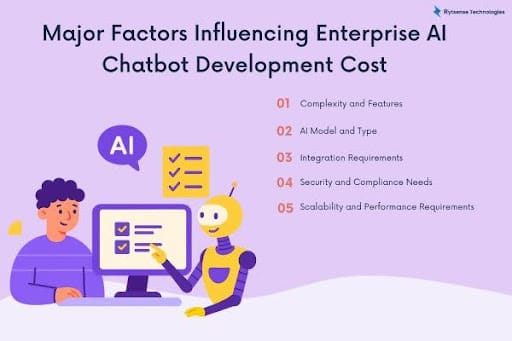
Complexity and Features
The different features of your AI chatbot can greatly affect its cost. Basic chatbots that can respond to basic questions or commands are considerably less expensive than sophisticated chatbots that can manage complex business processes, interact with multiple databases, and provide customized recommendations to users.
When you include advanced features such as: sentiment analysis, multilingual capabilities, voice recognition, and predictive analytics, the costs can rise dramatically. Generally, adding features means hours of development, requires developers with a special skillset, and will include ongoing maintenance so the increases compound on the overall cost.
AI Model and Type
The type of AI model you decide on also greatly affects the costs to develop your chatbot. Rule-based systems, which are basic, are the least expensive to implement. More advanced, and even very costly, models include neural-net systems or large language models, which represent a significant investment both in development and compute power.
In addition, Generative AI development services can represent significant costs in their own right however building chatbots using advanced models like GPT-4 provides more meaningful, usable, conversational applications, and can be a better option in the long run because those applications can also be more beneficial, faster to deliver content and less expensive to develop given their advanced conversational capabilities. Your selection of either a pre-trained model or the development of a custom AI model will have implications upfront on costs of development and costs of operations.
Integration Requirements
Enterprise chatbots must be integrated with existing enterprise software systems such as customer relationship management (CRM) systems, databases, payment systems, other third-party APIs, and reporting environments. Each integration point is an additional complexity and cost point for development.
The cost of AI integration services increases when working with legacy systems, complex database structures, and custom enterprise software. The number of integrations that you will require for your chatbot can easily double or triple the base development expense.
Security and Compliance Needs
Enterprise chatbots have security assurance and compliance requirement expectations that must be addressed. Some industries, such as government, financial services, and healthcare, have specific regulations governing chatbot operations. The need to comply with regulations and develop enterprise security adds to the complexity and cost of development.
Incorporating enterprise-level security capabilities like encryption of data, user authentication, data audit records, and privacy controls translates to longer development cycles and expertise requirements – all of which add to the overall Enterprise AI Chatbot Development Cost.
Scalability and Performance Requirements
Enterprise chatbots are designed to support a higher than typical volume of concurrent users, while also maintaining a fast response time. The ability to build systems that scale to support thousands of users who are participating in simultaneous conversations with a chatbot requires a solid infrastructure, as well as careful architectural considerations.
Additional cost to a chatbot development project comes from including performance enhancements, load balancing, and scalability features. Work with your internal technical team if you anticipate rapid growth or high volume usage when budgeting for technical requirements.
Enterprise AI Chatbot Development Cost in 2025: Estimated Price Ranges
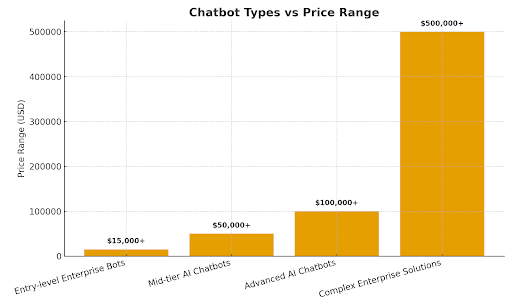
| Chatbot Type | Price Range | Key Features | Best For |
|---|---|---|---|
| Entry-level Enterprise Bots | $5,000 - $15,000 | Basic NLP, simple integrations, FAQ handling | Small businesses, simple use cases |
| Mid-tier AI Chatbots | $15,000 - $50,000 | Advanced NLP, multiple integrations, analytics | Medium businesses, customer service |
| Advanced AI Chatbots | $25,000 - $100,000+ | Contextual AI, machine learning, custom features | Large enterprises, complex workflows |
| Complex Enterprise Solutions | $100,000 - $500,000+ | Custom AI models, extensive integrations, enterprise security | Fortune 500, mission-critical applications |
Entry-level enterprise bots: $5,000 – $15,000
Basic enterprise bots have basic AI capabilities adequate for small to medium-size companies with basic requirements. These bots can handle basic customer inquiries, basic product knowledge, and basic lead information.
At this price range, you get basic natural language processing, basic integration with popular platforms, and basic security. There is no advanced capability in this bot tier, but it can provide some basic value to companies that are simply looking for basic customer service functionality.
Mid-tier AI chatbots with NLP: $15,000 – $50,000
NLP chatbots provide more advanced natural language processing, flow management for conversation, and integration with multiple business systems. NLP bots can provide more advanced conversational coverage and exhibit some level of personalized responses to customer inquiries based upon previous customer engagement history.
In this price range, the bot would also typically include sentiment analysis, basic machine learning capabilities, CRM integration, and more advanced dashboard analytics. These bots work well for companies that have moderately complicated customer inquiries.
Advanced AI chatbots with contextual intelligence: $25,000 – $100,000+
Intelligent enterprise chatbots increasingly employ sophisticated AI models that can provide context, remember conversation history, and provide intelligent recommendations. These systems are capable of automating complicated business processes and they can integrate with enterprise software systems.
At this level of investment, companies will receive chatbot systems that can provide contextual intelligence, advanced analytics, multi-channel interfaces, voice capabilities, and custom AI model training. This is a great fit for large, complex businesses with advanced customer service requirements.
Complex enterprise-grade solutions: $100,000 – $500,000+
The most advanced enterprise chatbots are usually custom-built solutions that sit at the core of a company's digital transformation strategy. At this investment level, the systems can integrate with multiple enterprise systems, and can employ proprietary AI models, often with extensive customization.
In exchange for a high level of investment, a company will receive a fully customized solution, with advanced security features, extensive integrations, custom AI model development, and comprehensive support services. Intelligent chatbots at this level often become a core business asset that drive operational improvements.

Phase-Wise Cost Distribution of Enterprise AI Chatbot Development
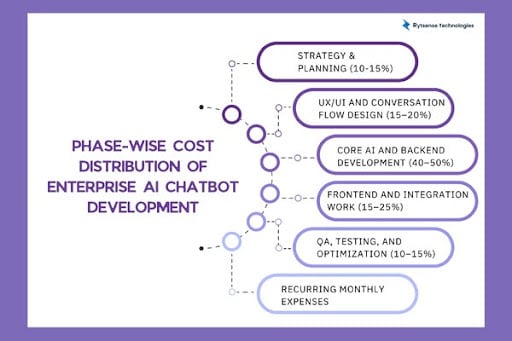
Knowing how the cost of Enterprise AI Chatbot Development breaks down by phase will allow organizations to more effectively scope budgets and timelines.
Strategy & planning (10-15%)
The Strategy and Planning phase is where you build an understanding of the business requirements, and relevant context for the chatbot, along with defining what objectives you have for the chatbot, and writing specifications for the project in detail. Generally, this phase is only 10-15% of the total project cost, but it is essential for project success.
AI consulting services are useful in this phase for defining the scope of the chatbot, determining which systems you want to integrate with, and defining success metrics. Getting this phase correct is key to avoiding costly iterative changes that could have easily been avoided.
UX/UI and conversation flow design (15–20%)
The design of the user interface and conversation (UX/UI) flow is a specialized expertise that focuses on an intuitive user experience. This phase represents 15-20% of the effort and will have the greatest impact on user adoption when the project is complete.
Good conversation design allows a user to easily engage with the chatbot, giving them the ability to get help when they require. Poor conversation design can lead to user frustration and ultimately project failure; which is why this portion of your budget is extremely important to an organization's success.
Core AI and backend development (40–50%)
The core AI development stage will generally be the largest section of the total project cost and will usually be between 40 to 50% of the total project costs. This stage includes the development of AI models, integrating natural language processing, and developing the backend systems.
A quality AI development company will put significant resources into this stage of development to make sure that the chatbot can understand user queries, generate accurate responses, and learn from the collective interactions of a segment of users.
Frontend and integration work (15–25%)
Frontend development and system integrating will typically be between 15 - 25 % of the project costs. Frontend development includes building user interfaces, integrating the chatbot into existing business systems, and establishing the data flow between platforms.
There can be a significant difference in integration complexity based on the number of systems and technical specifications. Legacy systems usually require a more expensive custom integration.
QA, Testing, and Optimization (10–15%)
Quality assurance testing and testing are usually 10-15% of your development costs. Quality assurance and testing of a chatbot is vital in delivering a reliable chatbot. This stage of development includes functional testing, performance testing, security testing, and user acceptance testing (UAT).
Testing occurs to ensure the chatbot will function correctly in a variety of conditions and provide consistent user experiences and quality of answers. If you choose not to implement adequate or thorough testing, you can create potentially expensive problems later.
Recurring monthly expenses
In addition to the original development costs, enterprises also incur ongoing operational costs for Enterprise chatbots such as hosting, maintenance, updates, and support. Depending on usage volume and complexity, these recurring monthly costs may range from $500 to $5,000.
"AI agents, especially if they are developed by an AI agent Development Company that may provide services beyond the initial launch, may offer support and maintenance as part of their services, which allows companies to plan their budgets, especially for ongoing chatbot development."
Also Read:
Top AI Agent development companies in 2025Industry-Specific Variations in Enterprise AI Chatbot Development Cost
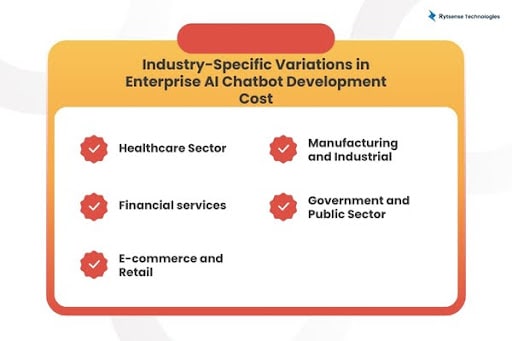
As in all things, there are industry-specific parameters that will now impact Enterprise AI Chatbot Development Cost. Knowing these differences will help the company establish realistic budgets based on the parameters associated with their industry.
Healthcare Sector
Healthcare chatbots are held to strict HIPAA compliance, along with advanced security needs and widespread integration with electronic health records. All of these specific requirements normally increase the cost of development by an additional 25-40% when compared to a standard chatbot.
Healthcare chatbots are typically called upon to deliver a specialized knowledge bases of medical knowledge, act as symptom checkers, handle appointment scheduling, and deal with prescriptions for potential patients. Due to the complexity of medical terminology, long approval processes, and regulatory requirements, in the end, development may become quite costly.
Financial services
Banking and financial services are similarly burdened with restrictive security requirements, fraud detection systems, and compliance to existing regulations that impact development costs on the order of 30-50% greater than baseline estimates.
Because financial chatbots must perform sensitive transactions, account inquiries, and offer investment advice, the entire process must comply with strict security procedures, including verification processes tied to existing core banking systems real-time transactional data, and facial recognition applications.
E-commerce and Retail
Retail chatbots deal mostly with product recommendations, order management, and customer service issues. The security requirements are only moderate, but the effort to integrate all three parts (inventory system, payment processor, shipping provider) is significant and complex.
In general, e-commerce chatbots are 10-20% more expensive than basic chatbots simply due to the technical work listing a product catalog, personalizing the chatbot to the e-commerce experience, and supporting multiple channels.
Manufacturing and Industrial
Manufacturing chatbots usually connect with supply chain systems with inventory management and production planning and scheduling solutions. Overall, the level of technical complexity of industrial systems can increase development costs by about 20-35%.
These types of chatbots must also often understand technical terminology, such as complex product specifications or mounting configurations, etc., since these specs are often technical documents that companies have invested time and money to develop. In this case, monetary value should be placed on the chatbot's ability to follow specification terminology and also the complexity of integrating the chatbot with the enterprise resource planning system used at that company.
Government and Public Sector
Government chatbots must often meet strict accessibility standards, security requirements, and transparency requirements. Compliance requirements often add approximately 25-40% to the overall development cost of building government-facing chatbots.
Public service or public sector-facing chatbots are often expected to provide multilingual support, accessible features for disabled users, and are often required to integrate with legacy government systems.
How to Reduce Enterprise AI Chatbot Development Cost Without Compromising Quality
Enterprising companies can reduce their Enterprise AI Chatbot Development Costs, while still getting a quality solution, leverage strategy and work with a vendor with the right capability.
Starting minimum viable product with focus on core functionality in order to allow for the addition of more sophisticated features post initial implementation.
This will not only provide initial saving but will allow companies to first validate their chatbot intentions and understand the value before investing significant development costs.
Spend some time selecting the vendor you wish to use for AI development who has functioned as a successful development partner in your specific industry, with the emphasis on quality and reducing expensive mistakes and developing efficiently.
Often experienced developers can leverage prior work with available frameworks and best practice which can result in time and cost savings on development.
Also, leverage whatever prebuilt AI models and platforms you can potentially use, rather than developing everything from scratch.
Many cloud service providers offer enterprise-worthy AI / ML capabilities and programs as part of their products that can create a significant amount of time and cost savings associated with development and build out strong functionality.
Take the time to carefully plan integrations and start with your most important integrations at first. Look to use a phased approach on integration that allows clients to spread out costs and to have flexibility based on true business value and actual budget cash flow.
Work with a company like Rytsense Technologies to explore all of your options to look at developing your business AI solution. Rytsense Technologies develop inspects your requirements for embedding the AI development services into their conversational / chat interfaces with the goal of looking at saving costs and time associated with the development process.
Comparing Cost Models: Custom, Pre-Built, and Platform-Based Solutions
| Solution Type | Cost Range | Development Time | Customization Level | Best For |
|---|---|---|---|---|
| No-code/Low-code Platforms | $1,000 - $10,000 | 2-8 weeks | Limited | Small businesses, simple use cases |
| Platform-based AI Services | $10,000 - $75,000 | 8-16 weeks | Moderate | Medium businesses, standard requirements |
| Custom Enterprise Solutions | $25,000 - $500,000+ | 12-52 weeks | Complete | Large enterprises, unique requirements |
No-code/low-code platforms: quicker and cheaper, but limited flexibility
No-code and low-code platforms also represent the cheapest way into enterprise AI chatbots and range in cost from $1,000 to $20,000. No-code and low-code platforms employ pre-built templates and enable fast structure through a drag-and-drop interface. However, they typically lack options for customization, advanced AI capabilities, and enterprise integrations. Their best use is for businesses with simple needs that want a fast deployment with limited ongoing upkeep.
Platform-based AI services: balanced cost with enterprise-level capabilities
Platform-based AI services provided by companies like Microsoft, Amazon, and Google range in cost from $10,000-$75,000 based on enterprise features needed and level of customization and integration required, while providing utilities of enterprise-level AI and lowering complexity and time to build, maintain or update. They provide good scalable and ongoing support and development costs are manageable.
Custom enterprise solutions: expensive but highly scalable and tailored
Custom enterprise solutions offer maximum flexibility and customization and therefore require the most investment. Deploying high-quality teams to hire AI developers aligned with the business will guarantee the precise chatbot your business needs. While the upfront investment cost may be high, custom chatbot enterprise solutions will typically create greater value over the long run due to having the perfect alignment with business processes, better performance, and easier maintenance and updates.
Calculating ROI on Enterprise AI Chatbot Development Cost
ROI Calculation Model
Calculating return on investment for enterprise AI chatbot development can be simple, if you understand both costs and benefits, and there is a time component involved. The basic ROI formula is:
ROI = (Total Benefits - Total Costs) / Total Costs × 100
What are the cost components?
Total costs represent the initial development investment, ongoing operational costs, maintenance costs, and staff training costs. Enterprises should budget 2-3 years of ongoing operational costs when calculating ROI.
What are the benefit categories?
Enterprise AI chatbots benefits can generally fall into one or more of the following benefit categories: customer service cost savings, increase sales conversion, positive customer satisfaction outcomes, and operational efficiencies.
Customer service cost savings
Most enterprises see a 40-60% reduction in customer-related service costs after deploying an AI chatbot. To calculate your cost savings, multiply your current service costs by the percentage of inquiries the chatbot will autonomously handle.
Revenue implications
Chatbots tend to provide a sales conversion increase of 10-30%, as they enhance the customers’ engagement process, allow for quicker response times, provide personalized product recommendations, and so on. Track the customer engagement conversion improvement to find a revenue impact.
Conclusion
Knowledge of Enterprise AI Chatbot Development Cost is vital when deciding where to allocate AI investments in 2025. Depending on the complexity of needs and features and industry-specific needs, costs will range from $5,000 for simple solutions to more than $500,000 for complex enterprise and bot solutions.
Success depends on finding the right development path to suit your business needs, working with an experienced team to develop your chatbot and factoring in initial development and ongoing operation costs. Enterprises interested in deploying enterprise AI chatbots to customers, employees or both, should be involved in making wise investments, as the return on investment (ROI) could be very lucrative - reducing costs, increasing customer satisfaction and engagement, and increasing operational efficiencies.
Rytsense Technologies offers fully understand AI Development Services and help companies work through these decisions to implement cost-effective solutions and chatbot solutions. Their experience in enterprise AI chatbot solutions is an advantage to ensure companies effectively invest in enterprise AI chatbots and receive maximum value associated with investment and development, while obtaining best-in-class solutions to meet budgets.


The Author
Karthikeyan
Co Founder, Rytsense Technologies